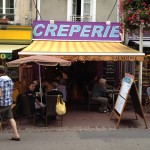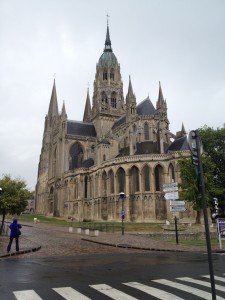 Paris, or rather Charles de Gaulle Airport, greeted us at 7:45 this morning.
Paris, or rather Charles de Gaulle Airport, greeted us at 7:45 this morning.
The wife, a/k/a Cindy, and I arrived before Ann and were met by the guide and driver our travel agency sent to take us to the Paris train station.
Our guide, Robert, is a former model, and our driver, Angel, bore a striking resemblance to Antonio Banderas.
I couldn’t figure out why our travel agency sent us two such extraordinarily good looking men, but somehow it made me feel important . . . or insecure.
Robert and Angel took us to the train station and to our first class seats on the train to Normandy. I use the term “first class” loosely because the term has to be loose enough to include 2 1/2 hours without any food or water and with only one amenity–a seat. I don’t travel well, but if you follow this blog you know that.
Bayeux is a town in Normandy, near the western coast of France. It is home to the Bayeux Tapestry, the Bayeux Cathedral and streets lined with interesting restaurants and shops.
After changing clothes, we walked into town for lunch. While Cindy and Ann were finishing lunch, I went to the creperie next door. Crepes are one of my favorite foods, and this crepe (crepe sucre citron) was the first of what I hope to be many on this trip.

After lunch we saw the Bayeux Tapestry, a cloth nearly the length of a football field created in 1070 (850 years before football) that in carefully embroidered pictures tells the story of William the Conqueror and the Battle of Hastings in 1066. We then visited the Bayeux Cathedral, a church consecrated in 1077.
The churches of the middle ages, like Bayeux Cathedral, represent remarkable artistic and architectural achievement.
Enlightenment and post-Enlightenment thinkers however have tried to rebrand the Middle Ages as the Dark Ages. As evidence, they cite the supposed lack of great buildings to compare to those of the Roman Empire.
In so doing, they completely overlook the churches of the Middle Ages. Medieval churches represent an ornate beauty and ingenuity that far surpass that of the Roman Empire.
The Romans built government structures (of which pagan temples were a part); the people of the Middle Ages built churches.
The practice of labeling the Middle Ages as the Dark Ages simply reflects the secularist bias to define human achievement in terms of the State rather than the Church.
We ended this first day in France in the hotel lounge where we passed on dinner in favor of champagne and a cheese plate before heading to our rooms for some well-needed sleep. GS
